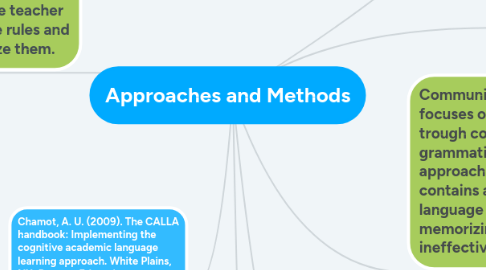Approaches and Methods
저자: Ashlee Alfred

1. Grammatical Approach: this approach is teacher-centered, meaning the teacher teaches the students language rules and the students study to memorize them.
1.1. Grammatical Methods: Grammar Translation- teacher presents reading, writing, and grammar rules and students memorize content and vocabulary, less emphasis on oral language development and more on reading, writing and grammar development. Direct- total immersion in L2, use of L1 is not allowed, teachers model and students practiced language patterns, vocabulary was taught in context through conversation. Audiolingual- language and grammar is taught in sequence, error corrections are often made, repetitive practice in L2
2. Balanced Reading Approach: differentiated learning drives instruction. Phonics instruction and reading authentic texts are combined and it includes stories and informational writing.
2.1. Cognitive Method: The metacognitive method such as Process Writing is a method that supports the Balanced Reading Approach because the informational writing process is guided through reflective writing strategies taught in the "Process Writing" method.
3. Chamot, A. U. (2009). The CALLA handbook: Implementing the cognitive academic language learning approach. White Plains, NY: Pearson Education.
4. Cognitive Approach: this approach involves information gathered in the environment, categorizing and organizing information, relating new information to background knowledge, using information in appropriate contexts, and the use of meta-cognition strategies.
4.1. Cognitive Methods: CALLA Method (cognitive- using reasoning and understanding of content to solve a problem, metacognitive- reflective thinking (ex: process writing), and social/affective- promoting a positive and cooperative learning environment)
5. Communicative Approach: this approach focuses on learning a second language trough communication. Contrasting with the grammatical approach; the communicative approach suggests that language production contains an infinite number of possible language combinations therefore, memorizing rules and patterns is mostly ineffective.
5.1. Communicative Methods: Silent Way- focuses on actions and experiences students see, teacher models and repetition/signals are often used. Natural Way- comprehensible input, encourage L1, minimal error correction. Suggestopedia- relaxed low anxiety environment, use L1, create understanding through conversation and visuals. Integrated Content Based- focus on L2 development, content & language integration, thematic units. Sheltered Instruction- grade level appropriate lessons, scaffold instruction, visuals and cooperative learning.
6. Language Experience Approach: for beginning language learners. Students learn oral language can be written down and read. The teacher will write down students' personal experiences they share which will be used as a reading text.
6.1. Communicative Methods would be appropriate to support beginner level learners in the Language Experience Approach because cooperative learning through conversation and the use of the students' L1 is essential for acquiring a L2.
7. Inquiry Approach: "any activity aimed at extracting meaning from experience". These are activities that move students through a cycle of learning experiences instead of learning from lecture, textbooks, or a worksheet.
7.1. The CALLA Method would be beneficial in supporting learning through the inquiry approach because building on background and making connections to new experiences through cooperative learning and reflection are all ways for students participate in cycles of learning experiences.


